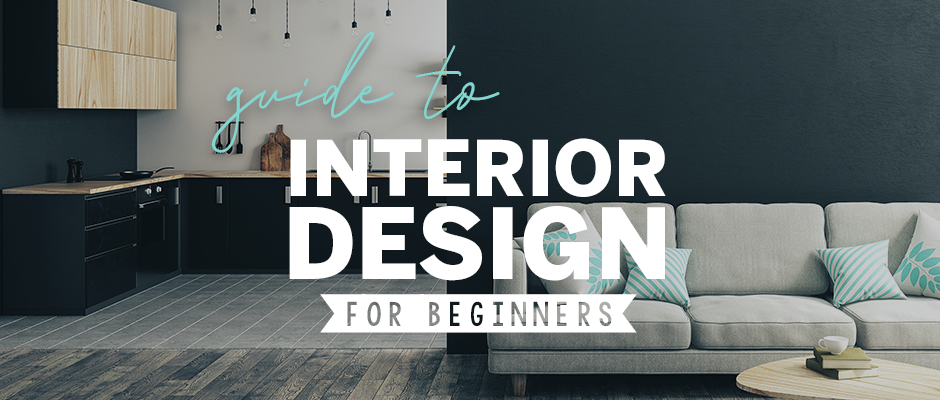So you’ve decided you want to decorate your home! It’s exciting to develop your own personal interior design style, but if you’re new to home decorating, it can feel like a big step. Fortunately, this guide to interior design for beginners makes it easy to get started. Read on to learn about different interior design styles and principles to shape your decisions.
Step 1: Choose Your Interior Design Style
The first important decision you should make is selecting a style for your home interior. By choosing an interior design style to flow throughout your home, you can tie all elements of your space together into a unifying experience. Here are four popular interior design styles that are easy to get started with.
Modern
A modern interior design style is characterized by clean lines. This look comes from a neutral color palette with pops of color, a few different textures, and an asymmetrical balance of furniture. Try directing attention around your room with iconic furnishings, such as funky lamps and glass coffee tables.
Industrial
An industrial interior design style brings a raw feel to your home. This interior design style is known for its exposed brick elements and steel appliances. This stripped-down infrastructure paired with various muted shades of browns and grays captures a “work-in-progress” vibe. Incorporate rustic wood pieces and metallic accents to achieve this distinctive look.
Contemporary
Known for its clean and tidy feel, a contemporary interior design style maximizes open spaces instead of adding clutter. To create a contemporary interior, work in neutral colors and subtle furniture with smooth edges. It won’t surprise you that this interior design style is often described as the crossover between simplicity and subtle sophistication.
Traditional
A traditional decor style is built around a warm color palette and welcoming textiles. You’ll love this interior design style if you appreciate consistency, attention to detail, and any opportunity to entertain your friends and family! Pair your comfortable furniture pieces with accents such as lush trim and classic moldings to get the traditional look.
Still unsure what to go for? Take our quiz to find the right interior design style for your home!
Step 2: Follow the Principles of Interior Design
Once you’ve settled on your favorite interior design style, you can begin planning the changes you’ll make to your home. There are hundreds of do’s and don’ts surrounding interior design, but there’s no need to let that hold you back. Following a few key interior design tips can keep you from feeling overwhelmed and still allow you to achieve beautiful results.
Use the following principles of interior design as a roadmap, rather than rules to follow. Remember, you want your home to look great, but you also want it to reflect your unique personality and suit your day-to-day needs.
Wall Hangings
Pieces of art can be great conversation-starters for your home. Place your wall hangings at eye-level to capture attention and bring your room together. Larger pieces of art or a series of smaller pieces are useful when trying to add additional character to large, empty spaces.
Mirrors, on the other hand, can create the illusion of more space. Along with reflecting natural light, they can also reduce energy use significantly. This interior design tip allows you to make a smaller space feel bigger, brighter, and airier.
Furniture and Large Home Items
Larger items in your home, such as furniture groups and modern fireplaces, are the most eye-catching aspects of a room. This means you should plan to spend a little more money on these items. Pick them out early on in your interior renovation process so you can treat them as your centerpieces and design around them.
Place your furniture at least a few inches from the wall to prevent your room from feeling cramped. The size of your pieces should also be consistent with the ratio of your room. Make sure to leave white space between all the items in your room to create a feeling of balance and spaciousness.

Lighting
An important interior design tip when considering lighting is to think about how you use the room. What you do in that space will determine the type of lighting you implement in your interior design style.
- Low lighting like ceiling lights, table lamps, or floor lamps offer good, general lighting.
- Task lighting, such as under-cabinet lighting and desk lamps, provide stronger, direct lighting. This is ideal for areas where you cook, read, and study.
- Accent lighting highlights specific areas or items in a room. For example, adding recessed lighting can illuminate darker corners or show off your wall hangings.
Installing dimmer switches throughout your home can help you change up the atmosphere in your space. This can keep your interior design style fresh and flexible for any occasion.
Pattern & Rhythm
By playing with patterns you can add layers and depth to your home. Choose your main pattern to anchor your space. This can be in the form of an accent wallpaper, a patterned furniture group, or window treatments. Any additional patterns should complement this first pattern. You can do this by using the same types of patterns but in different sizes.
When playing with patterns, utilize rhythm to move attention around the room and give your interior design style its own unique character. You can repeat or alternate elements, such as patterned throw pillows across your furniture group, or lamps around the room. You can also build on your patterns by deepening the color of the same pattern across your walls.
Colors
Whether you’re thinking about adding a patterned wallpaper to your room or not, you’ll need to choose the colors for your interior design style. The colors should reflect your personal preferences and work with the size and vibe of your room.
Reds, oranges, and yellow are warm colors that bring liveliness and intimacy to a room. Greens, blues, and purples are cool colors that are often used to create a feeling of calm and relaxation. Another interior design tip is to be aware of the size of your room. Warm colors in smaller spaces can often evoke a claustrophobic feel while cool colors in a spacious room can leave it feeling empty.
A new interior design project can seem like a daunting task, but with this guide to interior design for beginners, you have everything you need to get started. If you’re looking for home decor items you can make yourself, check out the DIY projects in this blog post!


